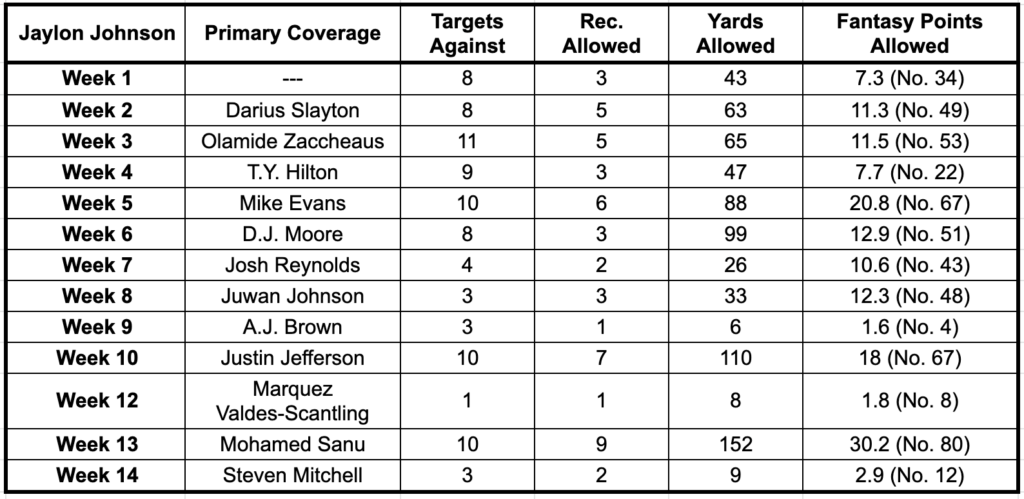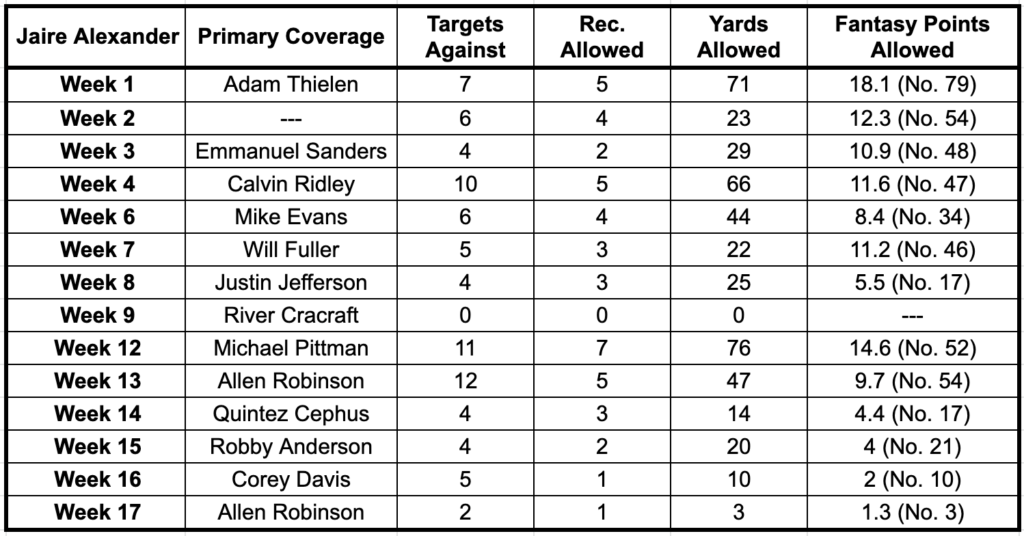Next up in our Meet the Metric series, we have Burn Rate. One awesome aspect of the fantasy football offseason involves the ability to dig into the data. What better place to dive into the data other than PlayerProfiler. If Burn Rate sounds like a receiver “burning” a defensive back, then we’re close and on track. As with every advanced metric, we need to look at the whole picture. How useful is it? We’ll find out as we uncover the data with some defensive backs with high and low Burn Rates. That said, let’s turn the heat up and dive right in.
Definition
Burn Rate is defined as “the percentage of targets allowed in which the defensive back’s assigned receiver gained more than five yards of downfield separation.” When looking at Burn Rate, we’re looking at which defensive backs gave up the highest and lowest rates of separation of five-plus yards or more. Although this is mainly a cornerback stat, it can help us identify positive or negative WR/CB matchups during the season. That said, we’ll also consider Target Separation and Average Cushion for wide receivers (much thanks to RotoUnderworld Director of Content Cody Carpentier for helping me understand this metric a bit better).
As we scroll through the leaderboards in Burn Rate for wide receivers, we find Tyreek Hill up at 8.2-percent, meaning he gained more than five yards of downfield separation on 8.2-percent of his targets against the opposing defensive back. Since this is typically a cornerback metric, we find 2020 rookie Jaylon Johnson of the Bears with an 8.0-percent (No. 76 among qualified cornerbacks) Burn Rate. That means he ranked dead last and gave up five-plus yards of separation on 8.0-percent of his targets. Not great. The two defensive backs ranked right ahead of Johnson were Denver’s Michael Ojemudia and Baltimore’s Marcus Peters.
Importance of Burn Rate in Fantasy and Real-Life Football
There’s the potential for us to key in on specific wide receiver and cornerback matchups, especially if we find someone like Tyreek Hill with a high Burn Rate matched up with a corner like Jaylon Johnson, who receivers burned quite a bit. As noted in the Run Blocking Efficiency article, we’ll also consider other metrics because looking at one alone doesn’t help us understand the whole picture.
As I sift through the data, I’ll touch on Johnson and another notable defensive back with a low Burn Rate. We’ll also consider some of their wide receiver matchups and note Target Separation and Average Cushion.
Target Separation & Average Cushion
A few other advanced metrics to consider when finding a defensive back with a high Burn Rate includes Target Separation and Average Cushion. Target Separation is defined as “a receiver’s average yards of separation from his assigned defender at the moment the pass arrives.”
Cushion is defined as “average cushion afforded to the receiver by his assigned defender on each route run.” Both metrics appear fairly straightforward, and we have a mix of speedsters and elite receivers with a high Target Separation or Average Cushion. Hence, why we’ll touch on those two metrics in addition to Burn Rate.
Burn Rate Outliers at Cornerback
Since Burn Rate is typically a cornerback metric, let’s look at a few outliers. The corners with the highest marks would fall into the fantasy-friendly category of matchups to target. As mentioned earlier, Jaylon Johnson ranked last with the highest Burn Rate in 2020. Later on, we’ll dig into the receivers he matched up with to see how they finished in terms of Target Separation.
Meanwhile, the corners with the lowest Burn Rates barely or didn’t allow a single target with five yards of separation. We ended up with 14 corners that allowed five yards of separation on zero-percent of their targets. Several notable names include Jaire Alexander, Stephon Gilmore, A.J. Bouye, and Bradley Roby.
However, a reminder that this isn’t the only metric to consider for cornerbacks. Others include Coverage Rating, Catch Rate Allowed, and Pass Break-ups Per Target. Since we have several cornerbacks with a 0.0-percent Burn Rate, we included Target Separation and Average Cushion.
Most Pass Break-Ups per Target?
1️⃣ Jaire Alexander: 0.21
2️⃣ Jaylon Johnson: 0.18 pic.twitter.com/eEeNQKNReG— RotoUnderworld (@rotounderworld) March 29, 2021
Jaylon Johnson, CB, Chicago Bears
The cornerback with the league’s highest Burn Rate, Jaylon Johnson faced several top-end wide receivers in his 13 games played in 2020. Meanwhile, he managed a +36.5 (No. 13) Coverage Rating and 16 (No. 4) Pass Break-ups.
We have a mix of notable receivers that performed well against Johnson in Mike Evans, D.J. Moore, and Justin Jefferson. Interestingly, we find low production from A.J. Brown and Marquez Valdes-Scantling with Johnson covering them. However, Brown still finished Week 9 on a high note, catching four of nine targets for 101 receiving yards and one touchdown. On Brown’s game logs, his primary coverage is listed as Kyle Fuller, which likely means Brown moved around the field and faced different defensive backs.
Let It Burn
Before you start singing “Let It Burn” by Usher, let’s dig into opposing receivers that faced Jaylon Johnson. On the flip side, Justin Jefferson torched him in Week 10. Jefferson hauled in seven of his ten targets for 110 receiving yards against Johnson, totaling 135 yards that week. Both Jefferson and A.J. Brown ranked as two of the most efficient wide receivers in 2020 evidenced by a +36.1 (No. 2) Production Premium for Brown and +23.1 (No. 9) Production Premium for Jefferson. It’s difficult to keep elite receivers in check, though it’s one matchup.
Interestingly, A.J. Brown ranked No. 79 with a 1.47 Target Separation mark and No. 10 with a 4.21 Average Cushion. Meanwhile, Jefferson finished with a 3.88 (No. 38) Average Cushion and 1.80 (No. 33) Target Separation mark. That indicates defenders gave Brown a high amount of cushion, though not as much separation when targeted. However, Jefferson ranked more middle-of-the-pack in both metrics. It’s possible for receivers to rank highly in both Target Separation and Average Cushion, though we’ll always consider the whole picture. A few notable receivers that ranked highly in both last year include Calvin Ridley and Brandin Cooks.
Jaylon Johnson held opponents to a 56.8% catch rate as a Rookie ? pic.twitter.com/yiyuFmtL9W
— RotoUnderworld (@rotounderworld) March 16, 2021
Meanwhile, we have Davante Adams with a 2.13 (No. 9) Target Separation mark, yet a lowly 3.54 (No. 70) Average Cushion. The same goes for Tyler Lockett, who boasted a 2.17 (No. 6) Target Separation mark and a 3.52 (No. 71) Average Cushion. Overall, we’re noting these receivers and metrics because if we find a receiver with a high Target Separation facing a defensive back with a high Burn Rate, it could lead to a fantasy-friendly matchup for that receiver.
Jaire Alexander, CB, Green Bay Packers
On the flip side, let’s look at Jaire Alexander, who allowed a 0.0-percent (No. 1) Burn Rate, tying with several other defensive backs. Meanwhile, he ranked No. 2 with a +54.9 Coverage Rating and No. 1 with 18 Pass Break-ups. Alexander dominated. Similar to what we reviewed with Jaylon Johnson, let’s look at the game logs for Alexander and touch on a few notable receiver matchups.
In Week 8, Alexander held Justin Jefferson in check with three receptions and 25 receiving yards. He also kept Allen Robinson quiet when they matched up. However, Robinson produced the No. 5 WR fantasy performance in Week 12 after he caught eight out of 13 targets with 74 receiving yards and two touchdowns. Overall, it’s wild to think Alexander didn’t allow a single burn against Adam Thielen, Calvin Ridley, Mike Evans, Will Fuller, Jefferson, and Robinson twice.
Shutdown Corner
Let’s finish out by touching on Target Separation and Average Cushion for a few receivers that faced up with Jaire Alexander. Allen Robinson ranked No. 84 with a 1.41 Target Separation mark and No. 74 with a 3.49 Average Cushion. He relied on opportunity yet lacked efficiency, evidenced by a 25.4-percent (No. 11) Target Share, 1,490 (No. 7) Air Yards, and a 32.2-percent (No. 21) Air Yards Share with a -1.0 (No. 48) Production Premium.
This Years Overall #1 on the https://t.co/JtvRe0ThgZ Cornerback Rankings
? Jaire Alexander – Green Bay ? pic.twitter.com/omJw6QX0s7
— RotoUnderworld (@rotounderworld) January 23, 2021
Meanwhile, Alexander shut down Robby Anderson in Week 15 for 20 receiving yards. Unsurprisingly, with Anderson’s speed, he ranked No. 7 with a 4.36 Average Cushion and No. 47 with a 1.68 Target Separation mark. We’ll note once again that we can identify some juicy receiver-defensive back matchups based on Burn Rate, Target Separation, and Average Cushion. Although Burn Rate is primarily a defensive back stat, it’s another metric to add to our toolbox of fantasy analysis. Personally, this is a metric I’ll continue to dive into throughout the season.









